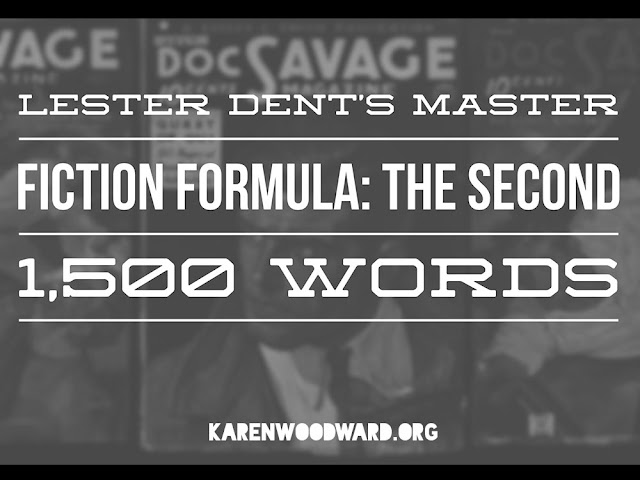This is the third post in this series. In the first post I went over the sort of things Dent said should be clarified before pen touches paper. In the second post we dove in and wrote the first 1,500 words.
Dent's master fiction formula applies to a 6,000 word story divided into four sections of 1,500 words each. Today, let's look at writing the second quarter.
Lester Dent's Master Fiction Formula
As we saw before, Dent wrote:
"This is a formula, a master plot, for any 6000 word pulp story. It has worked on adventure, detective, western and war-air. It tells exactly where to put everything. It shows definitely just what must happen in each successive thousand words.
"No yarn of mine written to the formula has yet failed to sell."
The second set of 1,500 words
Last time
- Introduced the characters.
- Talked about tags and traits. (Dent writes: "Characterizing a story actor consists of giving him some things which make him stick in the reader's mind. TAG HIM.")
- Set the hero's goal and demonstrated the stakes.
We introduced all our characters in the first 1,500 words. Last post, when we discussed how to introduce characters, I talked about tags and traits. Now, whenever we re-introduce a character we just mention one or two of their tags and traits to make sure the character is clear in the readers mind.
The Steps
This 1,500 word chapter should include:
1. "Shovel more grief onto the hero."
2. "Hero, being heroic, struggles, and his struggles lead up to:"
2a. "Another physical conflict."
2b. "A surprising plot twist to end the 1500 words."
Remember that this 1,500 segment/chapter will bring up to the midpoint so the surprising twist should probably change the way your character views the problem/the opposition. Often critical information is revealed to the hero, information that changes his (and our) perception of the antagonistic force.
Also, there is often a death (a symbolic death, or an ending of some sort) at the midpoint. (Keep in mind, too, that if the story has an upbeat, happy ending--if the hero achieves his/her goal--then this should be reflected in some way at the midpoint.)
The Midpoint
Remember that this 1,500 segment/chapter will bring up to the midpoint so the surprising twist should probably change the way your character views the problem/the opposition. Often critical information is revealed to the hero, information that changes his (and our) perception of the antagonistic force.
Also, there is often a death (a symbolic death, or an ending of some sort) at the midpoint. (Keep in mind, too, that if the story has an upbeat, happy ending--if the hero achieves his/her goal--then this should be reflected in some way at the midpoint.)
Check your work.
Written it? Great! Now double-check to make sure you're on track:
- Is it suspenseful?
- Is the hero being menaced? (Is there strong opposition and high stakes?)
- Is the hero being battered about? Being knocked down? Endangered? Beaten up? If so, great!
- Do the events flow naturally from one to the other? Are your character's responses reasonable? Believable?
- Do you tell our show? SHOW!! Dent writes:
"DON'T TELL ABOUT IT***Show how the thing looked. This is one of the secrets of writing; never tell the reader--show him. (He trembles, roving eyes, slackened jaw, and such.) MAKE THE READER SEE HIM."
A Minor Surprise
Dent holds: "When writing, it helps to get at least one minor surprise to the printed page."
I take this to mean: Include a minor surprise or twist.
Dent reveals that one way he accomplished this was to be, as he puts it, "gently misleading." For example:
"Hero is examining the murder room. The door behind him begins slowly to open. He does not see it. He conducts his examination blissfully. Door eases open, wider and wider, until--surprise! The glass pane falls out of the big window across the room. It must have fallen slowly, and air blowing into the room caused the door to open. Then what the heck made the pane fall so slowly? More mystery."
An example from Sleepy Hollow
A recent episode of Sleepy Hollow (S1, E8: Necromancer) had us suspect (SPOILER ALERT) Andy Brooks (played by John Cho) of being completely controlled by the headless horsemen; it turned out (surprise!) Andy was under orders from the demon (the one he sold his soul to) to keep Ichabod Crane from harm. Why? Because the demon had plans for Ichabod (cue diabolical laughter).
Great show, very fun. Anyway, that's another, more recent example, of writers being gently misleading.
Photo credit: "first rain" by Robert Couse-Baker under Creative Commons Attribution.


Please don't forget to write the about the third 1,500 hundred words of Lester Dent's Master Fiction Formula. This is an informative series. Perhaps you can also include some information on how to adapt this to other genre (romance etc.)
ReplyDeleteThanks for the reminder! I've put a sticky note above my desk so I won't forget.
DeleteIt's a great idea to look at Dent's formula with other genres in mind! I'll have to ponder that. In the meantime, here are links to a couple of posts I did about writing a romance:
The Rules of Romantic Comedy
http://blog.karenwoodward.org/2013/03/the-rules-of-romantic-comedy.html
What's The Difference Between Paranormal Romance And Urban Fantasy?
http://blog.karenwoodward.org/2012/11/whats-the-difference-between-paranormal-romance-and-urban-fantasy.html
In "What's The Difference ..." I talk a bit about the structure of a romance novel.
I will, though, keep your question in mind as I write the two remaining posts. Hope you're having a glorious winter holiday! :-)